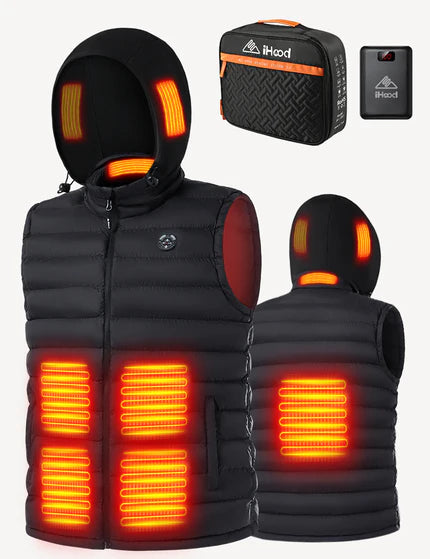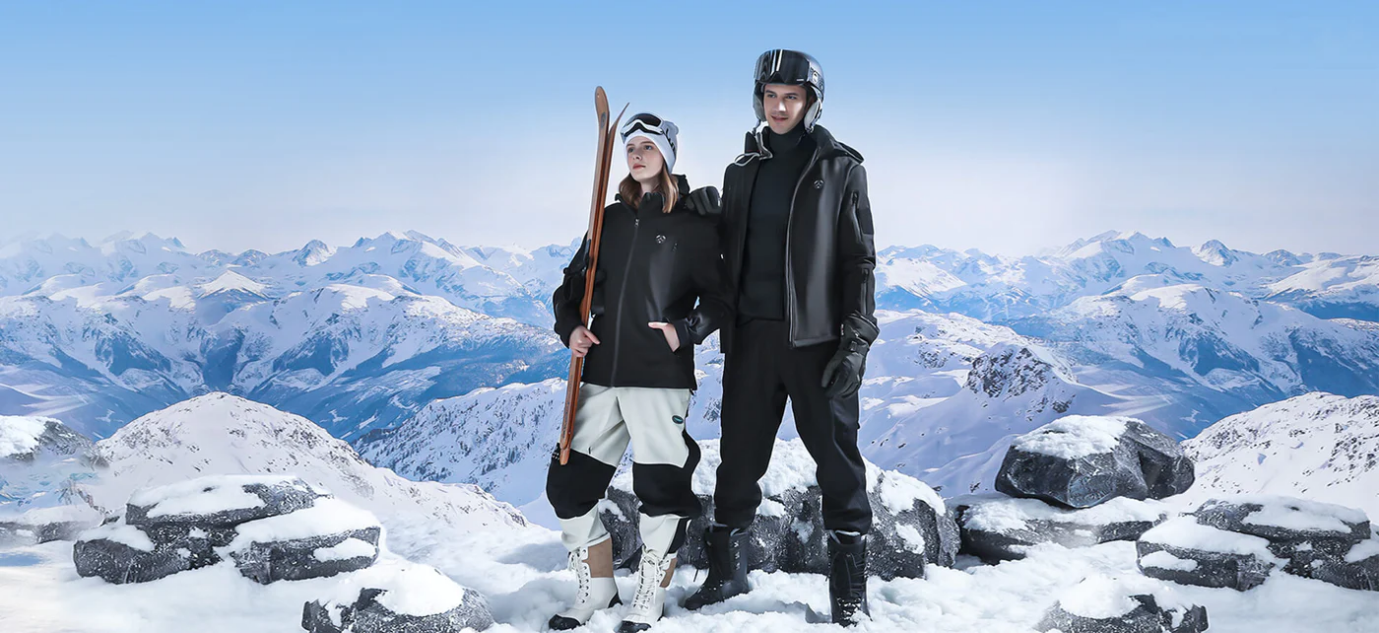Although heated clothes and jackets make it easy to feel warm in chilly weather, safety should always come first. Although useful, these clothing items have electric heating elements that must be used responsibly. Buying dependable goods from companies that follow safety regulations and certifications is essential to protect your safety.
It is crucial to provide proper upkeep, which includes routinely checking for signs of wear and tear. With improvements in technology and materials, iHood's heated clothing development has accelerated in the modern era. The first electrically heated garments were created for military people and astronauts who needed to be protected against extreme cold, and they grew more popular in the middle of the 20th century.
Early heated suits had a limited range of applications because they frequently required bulky, hefty power sources. The development of heated jackets has significantly benefited from advances in battery technology, which have increased their usefulness and functionality.
How Heated Jackets Work?
An article of winter apparel known as a heated jacket uses internal heating technology to keep wearers warm in chilly climates. Three essential parts make up its fundamental design: the heating element, the power source, and the temperature control. A heated jacket's central element is the heating element.
It comprises small, flexible panels or wires woven into the fabric and is often found in strategic places like the chest, back, and occasionally the collar or sleeves. When an electric current flows through these components, which are constructed of conductive materials like carbon fiber or metallic wires, heat is produced.
Rechargeable batteries or, in certain circumstances, external power sources are used to power heated jackets. The most popular option is rechargeable batteries because of its portability and ease. These batteries are often kept in the jacket's covert pockets or compartments. They give the heating elements the necessary electrical energy.
Depending on their comfort and the outside temperature, the user can select the preferred heat level. Following that, the control unit modifies the flow of electric current to the heating elements as necessary. Heated jackets occasionally have safety measures such as automatic shut-off mechanisms that go on if the jacket overheats or has an issue, protecting the user.
These iHood jackets' usage of high-end carbon fabric or graphene heating components is one of their primary safety features. They minimize the chance of explosions and possible burns by dispersing heat uniformly throughout the jacket. Additionally, most heated jackets feature three heating levels that let wearers customize the heat level to their comfort and preferences.


Battery Safety
The heated jacket battery is an essential element of heating clothing, supplying vital energy to heating factors. There is a complete overview of the battery used within the heating jacket, overlaying various components inclusive of its kind, material, battery life, safety, and greater.
Batteries That Use Lithium-ion (Li-Ion): The most popular type of battery for heated jackets is lithium-ion because of its high energy density, relatively lightweight, and long lifespan. They are the perfect choice for portable applications since they strike a reasonable balance between capacity and weight. Although Li-Ion batteries are typically safe, improper handling could result in some dangers.
Lithium-polymer (LiPo) Batteries: Lithium-polymer batteries have an energy density that is comparable to that of Li-Ion batteries, but they are more pliable and lighter in weight. They are frequently utilized in incredibly light or thin heated coats. Although LiPo batteries are typically regarded as safe when used as intended, damage or overcharging can make them vulnerable to thermal runaway, just like Li-Ion batteries.
Nickel-Cadmium (NiCd) Batteries: Due to its lower energy density, heavier weight, and problems with cadmium's environmental impact, NiCd batteries are less frequently used in heated jackets today. Although they can deliver dependable power, fewer people use them now that more sophisticated and environmentally friendly battery technologies are available.
The following safety considerations relate to heated jacket batteries:
Correct Charging: Users must use the supplied charger and adhere to the manufacturer's charging guidelines. Lithium battery overcharging can be risky. Modern heated jackets frequently come with built-in safety features that guard against overcharging.
Battery Management System: Many heated jackets come with battery management systems (BMS), which keep an eye on the battery's condition and manage it to prevent overcharging, over discharging, and overheating. This improves the battery's safety.
Physical Defense: The battery compartment in heated jackets is made to safeguard the battery from external damage and impact, lowering the possibility of short circuits or other problems.
Environmental Conditions: Extreme temperature ranges can have an impact on battery safety and performance. Battery safety is maintained through the use of heated jackets within acceptable temperature ranges and proper storage.
Advice To Maintain Battery
The longevity and safety of the batteries in iHood heated jackets depend on proper upkeep and charging. Here are some tips on how to go about it: Read the manufacturer's instructions and guidelines that are included with your heated jacket carefully to get started.
Manufacturers offer detailed instructions for maintaining and charging the batteries inside their goods. Always use the heated jacket's included charger. These chargers are necessary for a secure and effective charge because they are created especially for the battery and jacket.
In general, charging the batteries before they run completely dry is a good idea. When they are not entirely discharged, lithium-ion and lithium-polymer batteries often have a longer lifespan. When the batteries in your jacket are around 20 to 30% full, charge them.
Temperature Control And Overheating Protection
An iHood heated jacket's temperature control mechanism is made to let the user set the level of heat to their preferred level while guarding against overheating. This system often offers a number of settings, including low, medium, and high heat levels, and frequently offers means to precisely control the temperature for a customized experience.
Utilizing a heated jacket? Take these precautions to avoid overheating:
Choose The Right Setting: The right setting is one that takes current weather conditions and your level of exercise into account. Start with a lower setting and raise it gradually as necessary. Overheating is more likely when the highest heat setting is used unnecessarily.
Utilize Layering: By using multiple layers of clothing, you can more efficiently retain and spread heat, negating the need to turn the heated jacket's temperature up. Start with a decent insulating layer then add warmth with the heated jacket.
Watch the Battery: LED indicators that display the battery level and heat setting are frequently found on heated outerwear. Watch these signs to make sure the jacket is operating as it should. Stop wearing the jacket and speak with the manufacturer if you observe any strange behavior, such as an abnormally high heat output.
Examine the manual: Learn the instructions and suggestions for safe use provided by the manufacturer. On how to regulate temperature and use the jacket properly without overheating, the manual frequently includes helpful information.
Stay Hydrated: Staying hydrated is critical, as dehydration could make your body greater liable to overheating. Drink water regularly, especially in bloodless and dry situations, to assist in modifying your frame temperature.
Be Aware of Warnings: If your heated jacket has safety features like an automatic shut-off mechanism in case of overheating, pay attention to these alerts. They should not be disregarded because they are intended to shield you from extreme heat.
Keep Ventilation Open: Use the ventilation zippers or openings on your heated jacket as necessary to let out extra heat and moisture. A comfortable interior temperature can be maintained within the jacket with proper ventilation.


Importance Of Overheating Protection For User Safety
Overheating safety in iHood jackets, especially in heated clothing, is of paramount importance for consumer protection. The significance of this feature cannot be overstated, because it immediately addresses the risks associated with immoderate warmness and the potential effects of overheating.
First and major, overheating protection guarantees that the wearer is shielded from pain and, in extra extreme instances, burns or pores and skin inflammation. It prevents the jacket's heating factors from accomplishing temperatures that could damage the consumer. That is mainly essential whilst coping with electronic heating systems that are in close touch with the body.
Additionally, overheating protection takes care of any potential problems with thermal regulation in cold weather. Controlling the jacket's heat output is crucial since the body adapts to temperature variations naturally. Users of overheating protection devices can regulate their level of warmth and avoid overheating or sweating, which can cause a drop in body temperature when exposed to the cold.
User Feedback And Experience
Here are some actual user testimonials and experiences addressing the benefits and safety of wearing heated jackets:
"The iHood heated jacket has completely revolutionized the way I function outdoors in cold climates. I love the fact that it contains safety mechanisms to avoid overheating, which makes me feel secure during long, chilly shifts."
"I used an iHood heated jacket while camping in the cold. Knowing that the temperature control kept me warm without putting me at risk of overheating was incredibly comfortable. Adventurers who prefer frigid climates must have it."
"As someone who is easily chilled, I was initially dubious of heated clothing. But my iHood heated jacket's security and comfort pleasantly surprised me. It never gets too hot, and I have complete confidence that it will keep me warm."
"When I made the choice to check an iHood heated jacket, safety turned into my number one priority, and I'm happy with the effects. I feel confident wearing it because the modest heating elements don't feel hot to the touch."
Safety Precautions
Utilizing an iHood heated jacket efficiently necessitates adhering to a strict set of safety precautions and guidelines. Users using iHood heated jackets should take the following important safety precautions:
Battery Safety
Use only the charger that was supplied by the manufacturer. A different charger can result in overcharging and possible security risks. Never leave the batteries in your jacket on the charger for too long. Although the majority of heated jackets include built-in safeguards against overcharging, it is still preferable to unplug them after they have finished charging.
Keep the batteries in your heated jacket at around 50% of their capacity in a cool, dry location if you won't be using it for an extended period of time. Their longevity is increased as a result.
Maintenance And Cleaning
Check your iHood heated jacket for signs of wear and tear, such as frayed wires or damage to the heating elements, before each usage. If you discover any damage, don't wear the jacket. Follow the manufacturer's cleaning recommendations.
Many heated jackets may be washed in the washing machine, but you must take the battery out beforehand. Even though it is advertised as waterproof or water-resistant, never submerge your heated jacket in water. Although they may withstand a little wetness or light rain, submersion can harm the electrical parts.
Temperature Control And Safe Usage
Use the appropriate level of heat for the conditions and your level of exercise. Overheating can be avoided by starting with a lower setting and gradually raising it as necessary. Pay attention to the cues from your body. To prevent overheating, lower the heat or take a break if you feel too warm.
To efficiently transmit and retain heat, layer your garments. As a result, less of the jacket needs to be worn at high settings, minimizing overheating. Take brief breaks from wearing the heated jacket to allow your body time to regulate its temperature naturally.
Safety Concerns Addressed
Can a heated jacket electrocute you?
To reduce the risk of electrocution or electrical hazards, iHood heated jackets are built with a variety of safety features and put through rigorous testing. Insulating the heating elements, employing low-voltage systems, adding protective wiring and connectors, and putting battery management systems in place are some of these safety precautions.
Because of this, there is very little possibility of electrocution when using a heated jacket that is properly cared for and working. To avoid electrical problems, it's also essential to use the included charger and rechargeable batteries properly.
Can My Heated Jacket Catch Fire?
A well-made, well-maintained iHood heated jacket has a completely low chance of catching a fireplace. To lessen the hazard of the hearth, heated jackets are constructed with some protection precautions. These characteristics consist of battery protection gadgets, fireplace-resistant materials, and overheat protection.
Fire-resistant or flame-retardant substances reduce the hazard of combustion while overheating prevention prevents the heating assets from achieving risky temperatures. Protection precautions are included with rechargeable batteries to protect against overcharging and overheating.
Myth Debunked: Heated Jackets And Cancer Risk
There is a widespread misperception that iHood heated jackets, which employ low-voltage systems and heating elements driven by batteries, may be associated with an increased risk of cancer. However, this rumor is untrue. When used as intended, heated jackets don't increase the chance of developing cancer.
These clothing items have heating elements that are made to provide a controlled quantity of heat that is dispersed across a big region of the body, giving warmth in chilly weather. The low voltage systems employed in heated jackets operate at levels that are much below any recognized cancer risk. Trusting reputed companies for safe usage allows you to utilize iHood without risk.
Conclusion
Follow the manufacturer's directions and safety precautions to get the most out of heated jackets in cold weather while being safe. Users may confidently embrace the advantages of warming in chilly situations without unnecessary concerns thanks to the manufacturer's recommendations, which provide the basis for a safe and joyful experience with heated jackets.
FAQ About IHood Heating Jackets
1. How Should Your Heated Jacket Be Kept?
Keep your battery-heated motorcycle gear and other clothing in a clean, dry place. Storage containers need to be maintained out of the sun's direct rays and other sources of intense heat. Batteries MUST be recharged to at least 60% capacity once every three months to stay in functioning order.
2. How Do I Regulate The Temperature In My iHood Jacket?
Different heat settings, frequently low, medium, and high, are typically included with heated jackets. You can choose the preferred level of warmth with the help of some sophisticated models' accurate digital temperature controls.
3. Can iHood Heated Clothing Cause Overheating?
Modern heated jackets have safety features built in to guard against overheating. When used properly, overheating is unlikely because they are made to work within acceptable temperature ranges.
4. I Have a Heated Jacket; Can I Change The Battery?
There are several heated jackets that feature replaceable battery packs that can be taken off. However, it's crucial to use a battery with the same specifications as the original to guarantee compatibility.


